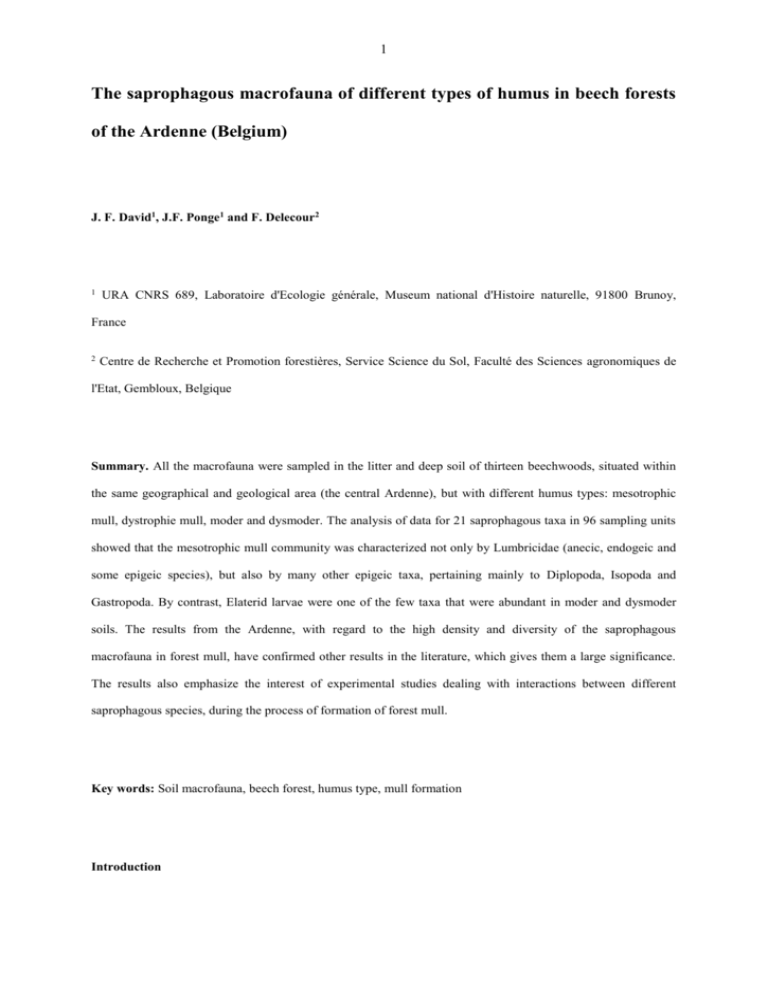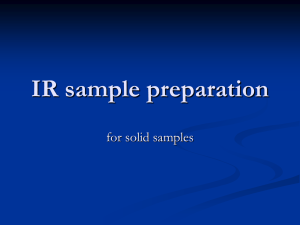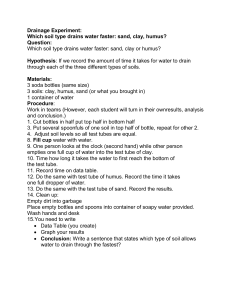1 The saprophagous macrofauna of different types of humus in
advertisement

1 The saprophagous macrofauna of different types of humus in beech forests of the Ardenne (Belgium) J. F. David1, J.F. Ponge1 and F. Delecour2 1 URA CNRS 689, Laboratoire d'Ecologie générale, Museum national d'Histoire naturelle, 91800 Brunoy, France 2 Centre de Recherche et Promotion forestières, Service Science du Sol, Faculté des Sciences agronomiques de l'Etat, Gembloux, Belgique Summary. All the macrofauna were sampled in the litter and deep soil of thirteen beechwoods, situated within the same geographical and geological area (the central Ardenne), but with different humus types: mesotrophic mull, dystrophie mull, moder and dysmoder. The analysis of data for 21 saprophagous taxa in 96 sampling units showed that the mesotrophic mull community was characterized not only by Lumbricidae (anecic, endogeic and some epigeic species), but also by many other epigeic taxa, pertaining mainly to Diplopoda, Isopoda and Gastropoda. By contrast, Elaterid larvae were one of the few taxa that were abundant in moder and dysmoder soils. The results from the Ardenne, with regard to the high density and diversity of the saprophagous macrofauna in forest mull, have confirmed other results in the literature, which gives them a large significance. The results also emphasize the interest of experimental studies dealing with interactions between different saprophagous species, during the process of formation of forest mull. Key words: Soil macrofauna, beech forest, humus type, mull formation Introduction 2 For more than a century, the very high abundance of earthworms (Oligochaeta: Lumbricidae) in mull-type humus has often been emphasized. However, the study carried out by Bornebusch (1930) in forests of Denmark has shown that mull soils are distinguishable from moder and mor soils not only by the abundance of Lumbricidae, but also by the high abundance of other taxa of the saprophagous macrofauna, such as Diplopoda, Isopoda and Gastropoda. The fact that different taxa may occur in the same site at high densities feeding on similar food resources, has sometimes been questioned on a speculative basis, with reference to interspecific competition (e.g. Kime, 1990 for Diplopoda and Lumbricidae). In fact, this question has not been resolved because there have been few other comparative studies taking into account all the soil macrofauna. Literature syntheses, such as Peterson & Luxton (1982), are of limited value for testing these relationships, as they compared data obtained from different areas, in different years and with different methods. As for studies explicitly designed for the comparison of macrofaunal abundance in different humus types, their sampling programmes were not always adapted to the census either of macroarthropoda (Eaton & Chandler, 1942), or of deep burrowing earthworms (Van der Drift, 1962). A noticeable exception was the comparison between the fauna of a mull and a moder recently made by Schaefer & Schauermann (1990) in Germany − though on very different substrata (the mull on limestone and the moder on acid soil). In the present study, sampling of the soil macrofauna was carried out simultaneously in a number of beechwoods of the central Ardenne (Belgium), with methods that made it possible to take the census of both epigeic and endogeic populations, in order to compare the structure of saprophagous communities in humus types ranging from mull to dysmoder. Materials and methods Features of the sites Thirteen beechwoods were chosen within a radius of about 20 km. All of them were on a common substratum, consisting of Eodevonian schists and sandstones. Detailed botanical and pedological features of the sites are provided by Manil et al. (1963) and Thill et al. (1988), and one can also refer to these papers for information about the climate and topography of the central Ardenne. General characteristics of the sites are given in table 1, notably the type of humus according to Delecour (1980). Owing to the acidity of the soil, moder and dysmoder soils were the most common, but there were also one mesotrophic and two dystrophic mull soils for comparative 3 purposes. Sampling of the soil macrofauna A total of 96 sampling units (s.u.) were taken in the thirteen sites: six s.u. in each site in June and October 1989, then six more s.u. in sites Nos. 1, 4 and 6 in May and October 1990. The procedure for each s.u. was as follows: (i) The litter and the upper soil layer were collected in a 30 x 30 cm quadrat (1/11 m2), in order to extract invertebrates by means of Tullgren funnels (25 cm in diameter; 13 cm in height above the grid; fitted with 40 W bulb). (ii) The same depth of litter and soil was removed froma 50 x 50 cm quadrat (1/4 m2), and 51 of 0.3% formaldehyde solution were applied to this area to expel the deep soil macrofauna. 5 l of 0.4% solution and 5 l of 0.5% solution were added at ten-minute intervals. (iii) The underlying soil was finally dug from a 30 x 30 cm quadrat and sorted by hand on a cloth. Most invertebrates were weighed alive in the laboratory, after cleaning on a wet filter paper. Some of them were weighed after preservation in 70% ethanol or 4% formaldehyde for less than a week. The results are expressed as number of individuals per m2 and fresh biomass (mg) per m2. Taxonomy The macrofauna taken into account in this study include the taxonomie groups listed by Petersen & Luxton (1982), with the exception of very small subgroups such as Chironomid larvae whose individual biomass was on average less than 1 mg. Individuals were identified according to Brauns (1954), Vandel (1960, 1962), Runham & Hunter (1970), Bouché (1972), Klausnitzer (1978), Demange (1981) and McAlpine et al. (1981). As far as possible, determination was carried on up to specific or generic level, but in some cases only family or subfamily was specified. That was the case for the Trichoniscinae (Isopoda) where the generic characters of the smallest individuals were not always obvious, and in most Insect larvae. No attempt was made to identify the different species of snails (Gastropoda, Stylommatophora). Data analysis 4 The data for 21 taxa in 96 s.u. were ordinated in reduced space by means of multidimensional analyses. Several methods were compared: principal component analysis (PCA) and correspondence analysis (CA), processing either original data (x), or data transformed into log (x + 1). The log transformation reduces the weight of s.u. in which one species concentrates, on account of highly aggregated distribution. Computation was made using MacMul and GraphMu packages (Thioulouse, 1989). In CA, the data displayed in the principal plane were symbolized by ellipses; their centre corresponds to usual co-ordinates and their horizontal and vertical amplitudes are proportional to the factorial variances on the studies axes. The differences in absolute abundance between the different humus types were tested by means of MannWhitney U-tests (Sokal & Rohlf, 1981). Results Taxonomic composition The saprophagous macrofauna sampled in the beechwoods of the Ardenne was divided into the 21 following taxa: (i) Five in the Lumbricidae (Oligochaeta): the species Lumbricus terrestris and Octolasium cyaneum; the genera Aporrectodea sp. (including at least A. caliginosa and A. rosea), Dendrobaena sp. (including at least D. octaedra and D. rubida) and Lumbricus sp. (including at least two other species, L. castaneus and L. rubellus). (ii) Six in the Diplopoda: the species Allajulus nitidus, Glomeris hexasticha and Iulus scandinavius; the genera Chordeuma sp. (including at least C. sylvestre), Craspedosoma sp. and Polydesmus sp. (undetermined species for lack of adult males). (iii) Three in the Isopoda: the species Ligidium hypnorum and Porcellium conspersum; the subfamily Trichoniscinae (including at least Trichoniscus pusillus). (One individual of Oniscus asellus, collected in site No. 8, was not taken into account in the analyses). (iv) Two in the Gastropoda: the genus Arion sp.; the order Stylommatophora (including several other species of snails). (v) Five in Insect larvae: the species Enoicyla pusilla (Trichoptera); the genus Fannia sp. (Diptera); the 5 subfamily Tipulinae (Diptera); the families Elateridae (Cole optera) and Sciaridae (Diptera). This set of taxa found in the samples should not be regarded as a complete faunal survey in the area. Other species probably live in the soils of the beechwoods of the Ardenne, even in the studied sites. For instance, Gaspar et al. (1981) collected two other Lumbricid species (Dendrobaena subrubicunda and Eisenia eiseni), in addition to the eight mentioned above. The list of macroarthropod species also seems too limited to be complete. Community analysis Using both PCA and CA, only the first axis segregated sets of sampling units which fitted in with the sites. The other axes were generated by the high frequency of particular groups in only one or two s.u. per site, and their validity must be proved by further samples. This may be a consequence of taking relatively few s.u. in each site, for some species with highly aggregated distribution patterns. The ordination on the first axis was similar with all methods, and the result obtained with CA of log transformed data is shown in fig. 1. There was a clear-cut distinction between the s.u. of site No. 1 (mesotrophic mull), corresponding to a large variety of taxa, and the s.u. of sites Nos. 3, 4, 5, 6, 7, 8, 10, 11, 12 and 13 (either moder or dysmoder), corresponding to a lower number of taxa where Elaterid larvae predominated. The s.u. of sites Nos. 2 and 9 (dystrophic mull) were in a middle position, for they shared taxa with site No. 1, and Elaterid larvae were comparatively less numerous than in the other sites. In site No. 1, the saprophagous macrofauna included (i) many epigeic forms (the most characteristic of which were P. conspersum, L. hypnorum, A. nitidus, I. scandinavius, Craspedosoma sp. and Stylommatophora), (ii) the endogeic forms Aporrectodea sp. and O. cyaneum, and (iii) one anecic species, as defined by Bouché (1972), L. terrestris. The low factorial variance of all these taxa on the first axis showed that they were characteristic of site No. 1. In contrast, taxa nearer to the origin on the first axis, such as Arion sp., Lumbricus sp. and Diptera larvae, had a high factorial variance on this axis, which showed that they were present in a wider range of s.u., in association with either the fauna of site No. 1 or Elaterid larvae. Absolute abundance The mean density during the time of the study, expressed as individual number and fresh biomass per m2, is 6 given in table 2 for each of the 21 taxa in each type of humus (mesotrophic mull, dystrophic mull, moder and dysmoder). Although, according to CA, moder and dysmoder soils were not segregated by their saprophagous macrofauna, they were still treated separately. It should be noted that the mean values of density were worked out to emphasize differences between humus types, but that this was somewhat arbitrary, in so far as the figures were far from being homogeneous in all the sites with the same type of humus. However, it is clear that, in the mesotrophic mull, the saprophagous macrofauna was not only more varied, but also significantly more abundant than in the other types of humus, in individual number as well as in biomass (P < 0.001 in all the U-tests for differences between total abundance values). First, this high density was due to eight taxa characteristic of the mesotrophic mull which were completely absent elsewhere. Secondly, other taxa present in several types of humus were significantly more abundant in the mesotrophic mull, namely L. terrestris (P < 0.01), Dendrobaena sp. (P < 0.001), Trichoniscinae (P < 0.01) as regards individual number and biomass, and G. hexasticha (P < 0.05) as regards biomass. On the other hand, total individual number and biomass were not significantly different between the other three types of humus. This means that dystrophic mull soils are more distinguishable from moder and dysmoder soils by the taxonomic composition than by the abundance of the macrofauna. From this standpoint, the statistical analysis of table 2 taxon by taxon confirmed some results obtained by CA: in particular, there were significantly fewer Elaterid larvae in dystrophic mull than in dysmoder (P < 0.01 for individual number). Discussion The comparison of forest sites with the same tree species, situated within the same geographical and geological area, has shown that the composition and abundance of the saprophagous macrofauna vary greatly according to the type of humus. Though two objections can be made to this first conclusion − (i) one single mesotrophic mull was studied in the Ardenne; (ii) the mull soils of sites Nos. 1, 2 and 9 corresponded to the lowest sites (cf. table 1), so that the differences in fauna could relate to altitude rather than humus type −, the results are nevertheless consistent with those in the literature, as regards the relationship between macrofauna and humus type. The general trends underscored by Bornebusch (1930) and confirmed by Schaefer & Schauermann (1990), have held true in respect of the beechwoods of the Ardenne. The mesotrophic mull was characterized by the high abundance of Diplopoda (in particular Iulida, Glomerida and Craspedosomatida), Isopoda and Gastropoda (in 7 particular snails), in addition to Lumbricidae. Furthermore, the Lumbricid community was characterized just as much by endogeic species (A. caliginosa, A. rosea and O. cyaneum), as by the anecic species L. terrestris. Some epigeic Lumbricidae were also much more abundant in the mesotrophic mull (in the genus Dendrobaena but not in the genus Lumbricus, as far as the Ardenne is concerned). This confirms that the saprophagous macrofauna of forest mull constitute communities with a high species diversity, where there is a tendency for most taxa to cohabit at high density levels. On the contrary, Elaterid larvae were one of the few taxa that were particularly abundant in moder and dysmoder, another fact already reported by Bornebusch and Schaefer & Schauernann. In the Ardenne, these larvae were the only taxon of the saprophagous macrofauna met with in some dysmoder humus (e.g. site No. 13). Two further comments must be made on the significance of these results. 1. In spite of their consistency with data from the literature, the results should not be given too general significance. In fact, the number of studies taking into account all the soil macrofauna remains low compared with the variety of natural conditions in forest ecosystems. That is why Kime's (1990) contention − that high density of earthworms could have a negative effect on litter-dwelling macroarthropoda − may prove correct in some instances. Zachariae (1965) referred to some concrete cases involving high densities of anecic earthworms in beech forests of central Europe, while considering they were exceptions; in the opinion of this author, “complete macrofauna” (i.e. with a high species diversity) were more common in mull-type humus. 2. No relationship of cause and effect between macrofauna and humus type could be established by the pesent study. One cannot overlook the fact that sampling does not make it possible to know to what extent soil fauna are merely attracted to mull conditions, and to what extent they really contribute to the mull morphology. Mull and moder/dysmoder are two ecological systems which differ in many descriptors (not only saprophagous macrofauna, but also herb layer, microflora, microfauna, mesofauna and many physicochemical properties of the soil), and a distinction between determining and secondary descriptors can only be made on experimental bases. However, a thorough knowledge of the dwellers of different humus types is of great interest to tackle experimental studies. For example, the biomass figures suggest that the formation of mull in temperate forests may not involve anecic species alone, nor Lumbricidae alone. In the present study, it was on average 12,762 mg/m2 for L. terrestris vs. 12,732 mg/m2 for the other taxa, epigeic and endogeic taken as a whole (cf. table 2). And though it is true that all the endogeic forms are Lumbricidae, on the other hand, epigeic forms which play an important role in the breakdown of leaf litter belong to a great extent to other groups, mainly macroarthropoda; 8 that was the case for the majority of individuals, and 40% of biomass, in the epigeic forms of the mesotrophic mull of the Ardenne. Consequently, experimental studies which aim at understanding the role of the saprophagous macrofauna in mull formation should take into account the high species diversity of communities, and focus not only on the action of big anecic earthworms, but also on possible interactions between epigeic and endogeic species (David, 1987; Scheu & Sprengel, 1989). Acknowledgements We are very grateful to R. D. Kime for his helpful comments, and we are indebted to F. Baarslag for his technical cooperation. References Bornebusch, C.H. (1930) The fauna of forest soil. Forst. Fors. Vaes. Danm. 11, 1-256. Bouché, M.B. (1972) Lombriciens de France. Ecologie et systématique. INRA, Paris. Brauns, A. (1954) Terricole Dipterenlarven. Musterschmidt, Göttingen. David, J.F. (1987) Relations entre les peuplements de Diplopodes et les types d'humus en forêt d'Orléans. Rev. Ecol. Biol. Sol. 24, 515−525. Delecour, F. (1980) Essai de classification pratique des humus. Pédologie 30, 225−241. Demange, J.M. (1981) Les mille-pattes. Myriapodes. Boubée, Paris. Eaton, T.H., Chandler, R.F. (1942) The fauna of forest-humus layers in New York. Cornell Univ. Agric. Exper. Station, Memoir 247, 1−26. Gaspar, C., Bouché, M., Laurent, G., Wonville, C. (1981) Recherches sur l'écosystème forêt: les Lombriciens des sols forestiers Ardennais. Annls. Soc. r. Zool. Belg. 111, 57−63. Kime, R.D. (1990) Spatio-temporal distribution of European millipedes. In: Minelli, A. (ed) Proc. 7th intern. Congr. Myriapod. Brill, Leiden, pp. 367−380. 9 Klausnitzer, B. (1978) Ordnung Coleoptera (Larven). Junk, The Hague. Manil, G., Delecour, F., Forget, G., El Attar, A. (1963) L'humus, facteur de station dans les hêtraies acidophiles de Belgique. Bull. Inst. agron. Stat. Rech. Gembloux 31, 28−102; 183−222. McAlpine, J.F., Peterson, B.V., Shewell, G.E., Teskey, H.J., Vockeroth, J.R., Wood, D.M. (1981) Manual of neartic Diptera. Vol. 1. Agriculture Canada. Petersen, H., Luxton, M. (1982) A comparative analysis of soil fauna populations and their role in decomposition processes. Oikos 39, 288−388. Runham, N.W., Hunter, P.J. (1970) Terrestrial slugs. Hutchinson Univ., London. Schaefer, M., Schauermann, J. (1990) The soil fauna of beech forests: comparison between a mull and a moder soil. Pedobiologia 34, 299−314. Scheu, S., Sprengel, T. (1989) Die Rolle endogäischer Regenwürmer im Ökosystem Kalkbuchenwald und ihr Zusammenwirken mit saprophagen Makroarthropoden. Verh. Ges. Okol. 17, 237−243. Sokal, R.R., Rohlf, F.J. (1981) Biometry. Freeman, New York. Thill, A., Dethioux, M., Delecour, F. (1988) Typologie et potentialités forestières des hêtraies naturelles de l'Ardenne centrale. I.R.S.I.A., Bruxelles. Thioulouse, J. (1989) Statistical analysis and graphical display of multivariate data on the Macintosh. Comput. Applic. Biosci. 5, 287−292. Vandel, A. (1960) Isopodes terrestres (Pemière partie). Faun. Fr. 64, Lechevalier, Paris. Vandel, A. (1962) Isopodes terrestres (Deuxième partie). Faun. Fr. 66, Lechevalier, Paris. Van der Drift, J. (1962) The soil animals in an oak-wood with different types of humus formation. In: Murphy, P.W. (ed) Progress in soil zoology. Butterworths, London, pp. 343−347. Zachariae, G. (1965) Spuren tierischer Tätigkeit im Boden des Buchenwaldes. Forstwiss. Forsch. 20, 1−68. 10 Legends of figures Fig. 1. Above: Display of 21 taxa in the principal plane of the CA (A.n.: A. nitidus; Ap.: Aporrectodea sp.; I.s.: I. scandinavius; P.c.: P. conspersum; St.: Stylommatophora). Below: Ordination of the sampling units from each site on the first axis of the same CA 11 Table 1. Situation and main features of the 13 studied beechwoods Site N° Nearest village Lambert coordinates (Longit./Latit.) Altitude (m) Vegetation Humus type 1 2 3 4 5 6 7 8 9 10 11 12 13 Saint-Hubert Saint-Hubert Saint-Hubert Saint-Hubert Saint-Hubert Saint-Hubert Haut-Fays Haut-Fays Houdremont Willerzie Willerzie Willerzie Willerzie 221, 92/85, 26 221, 93/85, 20 220, 81/85, 69 222, 00/84, 82 222, 03/84, 52 222, 90/83, 96 197, 13/80, 02 195, 86/79, 93 186, 81/69, 19 183, 38/73, 48 185, 97/72, 40 183, 67/72, 99 185, 94/72, 27 350 370 380 465 500 505 390 400 375 385 430 430 445 Melico-Fagetum festucetosum Luzulo-Fagetum festucetosum Luzulo-Fagetum vaccinietosum Luzulo-Fagetum festucetosum Luzulo-Fagetum typicum Luzulo-Fagetum vaccinietosum Luzulo-Fagetum festucetosum Luzulo-Fagetum typicum Luzulo-Fagetum festucetosum Luzulo-Fagetum vaccinietosum Luzulo-Fagetum typicum Luzulo-Fagetum vaccinietosum Luzulo-Fagetum vaccinietosum mesotrophic mull dystrophic mull dysmoder moder moder dysmoder moder moder dystrophic mull dysmoder moder dysmoder dysmoder 12 Table 2. Mean density, expressed as individual number and fresh biomass, for 21 saprophagous taxa in 4 types humus Anecic forms Oligochaeta Endogeic forms Oligochaeta Oligochaeta Epigeic forms Oligochaeta Oligochaeta Diplopoda Diplopoda Diplopoda Diplopoda Diplopoda Diplopoda Isopoda Isopoda Isopoda Gastropoda Gastropoda Insecta (larvae) Insecta (larvae) Insecta (larvae) Insecta (larvae) Insecta (larvae) Total mesotrophic mull (site No. 1) (12 s. u.) dystrophic mull (sites Nos. 2, 9) (12 s. u.) moder (sites Nos. 4, 5, 7, 8, 11) (36 s. u.) dysmoder (sites Nos. 3, 6, 10, 12, 13) (36 s. u.) Ind./m2 mg/m2 Ind./m2 mg/m2 Ind./m2 mg/m2 Ind./m2 mg/m2 L. terrestris 14 12762 Aporrectodea sp. O. cyaneum 29 2 3235 1791 <1 − − 101 − − − − − − − − − − − − − − Dendrobaena sp. Lumbricus sp. A. nitidus I. scandivavius Craspedosoma sp. Chordeuma sp. G. hexasticha Polydesmus sp. L. hypnorum P. conspersum Trichoniscinae Arion sp. Stylommatophora E. pusilla Fannia sp. Tipulinae Sciaridae Elateridae 55 3 19 8 32 19 22 3 7 4 80 5 14 5 9 15 2 13 2921 1549 646 746 72 96 326 30 63 36 61 477 94 38 62 370 3 121 1 4 − − − 19 6 3 − − 6 − − 3 3 5 − 34 64 766 − − − 157 10 1 − − 6 − − 17 22 229 − 220 <1 1 − − − <1 − 3 − − − 1 − − 2 4 3 59 121 431 − − − <1 − 25 − − − 153 − − 12 466 4 530 1 − − − 3 − − − − <1 <1 − − 2 3 1 93 591 − − − 19 − − − − <1 634 − − 10 256 1 546 360 25499 84 1593 73 1742 103 2057 13 Fig. 1







